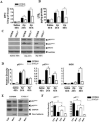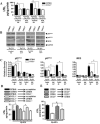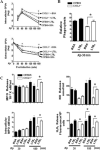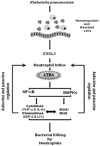Intrapulmonary administration of leukotriene B(4) augments neutrophil accumulation and responses in the lung to Klebsiella infection in CXCL1 knockout mice
- PMID: 22379035
- PMCID: PMC3311767
- DOI: 10.4049/jimmunol.1101985
Intrapulmonary administration of leukotriene B(4) augments neutrophil accumulation and responses in the lung to Klebsiella infection in CXCL1 knockout mice
Abstract
In prior studies, we demonstrated that 1) CXCL1/KC is essential for NF-κB and MAPK activation and expression of CXCL2/MIP-2 and CXCL5/LPS-induced CXC chemokine in Klebsiella-infected lungs, and 2) CXCL1 derived from hematopoietic and resident cells contributes to host immunity against Klebsiella. However, the role of CXCL1 in mediating neutrophil leukotriene B(4) (LTB(4)), reactive oxygen species (ROS), and reactive nitrogen species (RNS) production is unclear, as is the contribution of these factors to host immunity. In this study, we investigated 1) the role of CXCL1 in LTB(4), NADPH oxidase, and inducible NO synthase (iNOS) expression in lungs and neutrophils, and 2) whether LTB(4) postinfection reverses innate immune defects in CXCL1(-/-) mice via regulation of NADPH oxidase and iNOS. Our results demonstrate reduced neutrophil influx, attenuated LTB(4) levels, and decreased ROS and iNOS production in the lungs of CXCL1(-/-) mice after Klebsiella pneumoniae infection. Using neutrophil depletion and repletion, we found that neutrophils are the predominant source of pulmonary LTB(4) after infection. To treat immune defects in CXCL1(-/-) mice, we intrapulmonarily administered LTB(4). Postinfection, LTB(4) treatment reversed immune defects in CXCL1(-/-) mice and improved survival, neutrophil recruitment, cytokine/chemokine expression, NF-κB/MAPK activation, and ROS/RNS production. LTB(4) also enhanced myeloperoxidase, H(2)O(2,) RNS production, and bacterial killing in K. pneumoniae-infected CXCL1(-/-) neutrophils. These novel results uncover important roles for CXCL1 in generating ROS and RNS in neutrophils and in regulating host immunity against K. pneumoniae infection. Our findings suggest that LTB(4) could be used to correct defects in neutrophil recruitment and function in individuals lacking or expressing malfunctional CXCL1.
Figures







Similar articles
-
CXCL1 regulates pulmonary host defense to Klebsiella Infection via CXCL2, CXCL5, NF-kappaB, and MAPKs.J Immunol. 2010 Nov 15;185(10):6214-25. doi: 10.4049/jimmunol.0903843. Epub 2010 Oct 11. J Immunol. 2010. PMID: 20937845 Free PMC article.
-
Both TRIF- and MyD88-dependent signaling contribute to host defense against pulmonary Klebsiella infection.J Immunol. 2009 Nov 15;183(10):6629-38. doi: 10.4049/jimmunol.0901033. Epub 2009 Oct 21. J Immunol. 2009. PMID: 19846873 Free PMC article.
-
CXCL1 regulates neutrophil homeostasis in pneumonia-derived sepsis caused by Streptococcus pneumoniae serotype 3.Blood. 2019 Mar 21;133(12):1335-1345. doi: 10.1182/blood-2018-10-878082. Epub 2019 Feb 5. Blood. 2019. PMID: 30723078 Free PMC article.
-
SKAP2 is required for defense against K. pneumoniae infection and neutrophil respiratory burst.Elife. 2020 Apr 30;9:e56656. doi: 10.7554/eLife.56656. Elife. 2020. PMID: 32352382 Free PMC article.
-
Towards a four-dimensional view of neutrophils.Methods Mol Biol. 2012;844:87-99. doi: 10.1007/978-1-61779-527-5_6. Methods Mol Biol. 2012. PMID: 22262436 Review.
Cited by
-
Organ Failure Due to Systemic Injury in Acute Pancreatitis.Gastroenterology. 2019 May;156(7):2008-2023. doi: 10.1053/j.gastro.2018.12.041. Epub 2019 Feb 12. Gastroenterology. 2019. PMID: 30768987 Free PMC article. Review.
-
IFN-β Improves Sepsis-related Alveolar Macrophage Dysfunction and Postseptic Acute Respiratory Distress Syndrome-related Mortality.Am J Respir Cell Mol Biol. 2018 Jul;59(1):45-55. doi: 10.1165/rcmb.2017-0261OC. Am J Respir Cell Mol Biol. 2018. PMID: 29365277 Free PMC article.
-
Neuronal Nitric Oxide Synthase Contributes to PTZ Kindling-Induced Cognitive Impairment and Depressive-Like Behavior.Front Behav Neurosci. 2017 Oct 18;11:203. doi: 10.3389/fnbeh.2017.00203. eCollection 2017. Front Behav Neurosci. 2017. PMID: 29093670 Free PMC article.
-
Distinct Contributions of Neutrophils and CCR2+ Monocytes to Pulmonary Clearance of Different Klebsiella pneumoniae Strains.Infect Immun. 2015 Sep;83(9):3418-27. doi: 10.1128/IAI.00678-15. Epub 2015 Jun 8. Infect Immun. 2015. PMID: 26056382 Free PMC article.
-
Compartment-specific and sequential role of MyD88 and CARD9 in chemokine induction and innate defense during respiratory fungal infection.PLoS Pathog. 2015 Jan 26;11(1):e1004589. doi: 10.1371/journal.ppat.1004589. eCollection 2015 Jan. PLoS Pathog. 2015. PMID: 25621893 Free PMC article.
References
-
- Fein AM. Pneumonia in the elderly: overview of diagnostic and therapeutic approaches. Clin Infect Dis. 1999;28:726–729. - PubMed
-
- Lynch JP, 3rd, Martinez FJ. Community-acquired pneumonia. Curr Opin Pulm Med. 1998;4:162–172. - PubMed
-
- Abraham E. Neutrophils and acute lung injury. Critical Care Medicine. 2003;31:S195–S199. - PubMed
Publication types
MeSH terms
Substances
Grants and funding
LinkOut - more resources
Full Text Sources
Molecular Biology Databases
Research Materials

